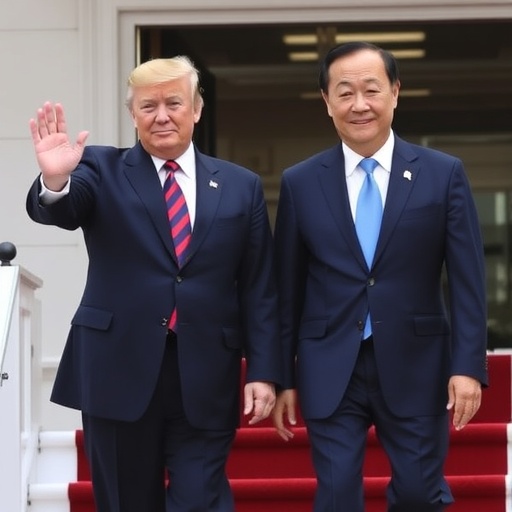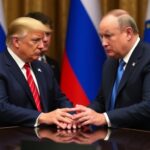Trump Launches Asia Tour with Landmark Meeting to Japan’s PM Takaichi, Bolstering US-Japan Alliance
In a pivotal moment for trans-Pacific diplomacy, President Donald Trump touched down in Tokyo on Monday, kicking off a three-day visit to Japan that underscores the renewed vigor of the US-Japan alliance amid rising global tensions. This trip marks Trump‘s first official foray into Japan since assuming office for his second term in January, setting the stage for his inaugural in-person dialogue with Japan’s newly appointed Prime Minister Sanae Takaichi. As the Asia tour unfolds, all eyes are on how these leaders will navigate trade, security, and regional stability in an era of geopolitical flux.
- Trump’s Grand Arrival in Tokyo Ignites Diplomatic Excitement
- Sanae Takaichi Emerges as Japan’s Bold New Voice in Global Affairs
- Core Talks Focus on Fortifying the US-Japan Alliance Amid Regional Tensions
- Trump’s Asia Tour Sets Stage for Multilateral Engagements Beyond Japan
- Anticipating Outcomes: How US-Japan Talks Could Reshape Asia-Pacific Dynamics
Trump’s Grand Arrival in Tokyo Ignites Diplomatic Excitement
President Trump’s Air Force One landed at Haneda Airport under a crisp autumn sky, greeted by a contingent of Japanese officials and a modest yet enthusiastic crowd waving American and Japanese flags. The arrival ceremony, steeped in tradition, featured a honor guard and national anthems, signaling the deep-rooted respect between the two nations. Trump, donning his signature red tie, stepped off the plane with a broad smile, immediately engaging with the press corps trailing his delegation.
“Japan has always been a steadfast ally, and under my administration, we’re going to make that partnership even stronger,” Trump declared in his first remarks upon arrival. This visit comes at a crucial juncture, just months after Takaichi’s ascension to the premiership in a surprising shift within Japan’s Liberal Democratic Party (LDP). Sources close to the White House indicate that the itinerary was meticulously planned to blend ceremonial pomp with substantive talks, including a state dinner at the Imperial Palace and bilateral meetings at the Prime Minister’s residence.
Historically, U.S. presidential visits to Japan have been milestones in alliance-building. Recall President Barack Obama’s 2014 trip, which emphasized shared democratic values, or Trump’s own 2017 summit with then-Prime Minister Shinzo Abe, where golf diplomacy paved the way for trade concessions. This time, with Takaichi at the helm—a figure known for her hawkish stance on national security—the dynamics promise to be even more charged. Economic data underscores the stakes: bilateral trade between the U.S. and Japan reached $296 billion in 2023, with Japan as the U.S.’s fourth-largest trading partner. Yet, challenges like U.S. tariffs on Japanese autos and Japan’s push for digital trade rules loom large.
The excitement in Tokyo is palpable. Local media outlets, from NHK to Asahi Shimbun, have dubbed the visit “The Takaichi-Trump Accord,” speculating on breakthroughs in defense cooperation. Security experts note that Japan’s recent defense budget hike to 2% of GDP by 2027—doubling from previous levels—aligns perfectly with Trump’s “America First” push for allies to shoulder more burden-sharing in the Indo-Pacific.
Sanae Takaichi Emerges as Japan’s Bold New Voice in Global Affairs
Prime Minister Sanae Takaichi, a 63-year-old veteran politician with a reputation for unyielding conservatism, represents a fresh chapter in Japan’s leadership. Appointed in late summer following a party reshuffle, Takaichi’s rise from education minister to the nation’s top post has been meteoric. Her background as a key Abe ally, advocating for constitutional revisions to expand Japan’s military role, positions her as an ideal counterpart for Trump’s muscular foreign policy.
In a pre-visit interview with Reuters, Takaichi emphasized the enduring bond: “The US-Japan alliance is the cornerstone of peace in Asia. With President Trump, we aim to elevate it to new heights.” Her agenda includes addressing North Korea’s missile threats—over 100 launches in the past year alone—and countering China’s assertiveness in the South China Sea. Takaichi’s domestic popularity, hovering at 55% in recent polls by Yomiuri Shimbun, stems from her focus on economic revitalization and gender equality initiatives, making her a relatable figure in a nation grappling with an aging population.
Trump’s team has praised Takaichi’s pragmatism. National Security Advisor Jake Sullivan, traveling with the president, highlighted her during a briefing: “PM Takaichi brings a clear-eyed view of the challenges ahead, from supply chain resilience to joint military exercises.” Indeed, the two leaders share common ground on issues like intellectual property protection, where Japan has pledged $10 billion in investments to U.S. tech sectors under recent frameworks.
Yet, not all is seamless. Critics in Tokyo worry that Takaichi’s nationalist leanings could strain relations with neighbors like South Korea, potentially complicating Trump’s broader Asia tour. Her visit to the Yasukuni Shrine earlier this year drew international ire, reminding observers of the alliance’s delicate historical undercurrents. Still, for the US-Japan alliance, Takaichi’s tenure offers opportunities: enhanced interoperability in cybersecurity, with joint drills planned for 2025, and collaborative R&D in semiconductors to reduce dependence on Chinese manufacturing.
Core Talks Focus on Fortifying the US-Japan Alliance Amid Regional Tensions
The centerpiece of Trump’s Japan visit is the closed-door meeting with Takaichi, scheduled for Tuesday afternoon at the Kantei. Agenda items span trade negotiations, defense pacts, and climate cooperation, but the US-Japan alliance remains the beating heart. With China’s military spending surpassing $292 billion annually—nearly triple Japan’s—bolstering this partnership is non-negotiable.
Key discussions will revolve around the Quad alliance (U.S., Japan, Australia, India), which Trump seeks to reinvigorate. During his first term, the Quad laid groundwork for joint naval patrols; now, with Takaichi’s support, expect expansions into economic security. A White House fact sheet released Monday outlines commitments: $50 billion in joint infrastructure projects across Southeast Asia to counter Beijing’s Belt and Road Initiative.
Quotes from insiders paint a collaborative picture. Japanese Foreign Minister Yoko Kamikawa stated, “This summit will chart a course for mutual prosperity and security.” On the U.S. side, Commerce Secretary Gina Raimondo previewed trade talks: “We’re looking at fair deals that benefit American workers and Japanese innovators alike.” Statistics bolster the narrative: U.S. forces in Japan number 54,000, supporting over 25,000 Japanese jobs, while joint exercises like Keen Sword have simulated defenses against hypothetical invasions.
Challenges persist, however. Trump’s proposed 10-20% tariffs on imports could hit Japan’s export-driven economy hard, with automakers like Toyota facing $20 billion in potential costs. Takaichi is pushing for exemptions, leveraging her party’s pro-business stance. Additionally, the alliance faces tests from Russia’s Ukraine invasion parallels in Asia, prompting talks on sanctions coordination—Japan has already frozen $100 billion in Russian assets.
Beyond bilaterals, side events include a business roundtable with CEOs from Boeing and Mitsubishi, aiming to ink deals worth $15 billion in aerospace. Environmental pledges, too, feature prominently: joint hydrogen energy projects to meet net-zero goals by 2050, aligning with Trump’s recent executive order on clean tech.
Trump’s Asia Tour Sets Stage for Multilateral Engagements Beyond Japan
While Japan anchors the itinerary, Trump’s Asia tour extends to South Korea and the Philippines, weaving a tapestry of alliances. In Seoul on Wednesday, he’ll address U.S. troop presence amid North Korean provocations—Kim Jong-un’s regime tested 30 missiles in 2024 alone. Then, in Manila, discussions with President Ferdinand Marcos Jr. will focus on South China Sea freedom of navigation, where U.S. carrier strikes have deterred Chinese encroachments.
This tour, Trump’s most ambitious foreign outing yet, reflects a strategic pivot. Per a Council on Foreign Relations report, 70% of Americans view China as the top threat, driving Trump’s emphasis on alliances. In Japan, cultural exchanges add warmth: Trump will tour a sake brewery and sample kaiseki cuisine, fostering people-to-people ties that underpin the US-Japan alliance.
Regional analysts are optimistic. Brookings Institution fellow Mira Rapp-Hooper noted, “Trump’s visit could catalyze AUKUS-like tech-sharing with Japan, accelerating hypersonic missile development.” Economically, the tour promises ripple effects: projected $200 billion in deals across stops, from semiconductors in Japan to EVs in Korea.
Public sentiment varies. A Pew Research poll shows 80% of Japanese favor strong U.S. ties, up from 65% in 2020, while U.S. approval of Japan hovers at 85%. Protests, though minimal, highlight anti-base sentiments in Okinawa, where 70% of U.S. forces are stationed, prompting talks on relocation.
Anticipating Outcomes: How US-Japan Talks Could Reshape Asia-Pacific Dynamics
As Trump’s Japan visit progresses, the ripple effects on the Asia tour and beyond are profound. A successful Takaichi-Trump summit could yield a new defense framework, including real-time intelligence sharing via upgraded Five Eyes extensions. Trade-wise, exemptions from universal tariffs might stabilize markets, with the Nikkei index already up 2% on visit news.
Looking forward, implications extend to global supply chains. With Japan committing to diversify from China—$30 billion in reshoring investments—the US-Japan alliance could lead a “friend-shoring” wave, benefiting U.S. manufacturing hubs in the Rust Belt. Security-wise, joint patrols in the Taiwan Strait may intensify, deterring aggression and reassuring allies like Taiwan, which relies on 60% of its arms from the U.S.
Challenges remain, including domestic politics: Trump’s midterm promises demand quick wins, while Takaichi navigates LDP factions. Yet, the momentum is clear. As one State Department official put it, “This isn’t just a visit; it’s a blueprint for the next decade in Asia.” With the world watching, the US-Japan alliance stands poised to evolve, fortifying stability in a volatile region and advancing shared visions of prosperity and peace.








